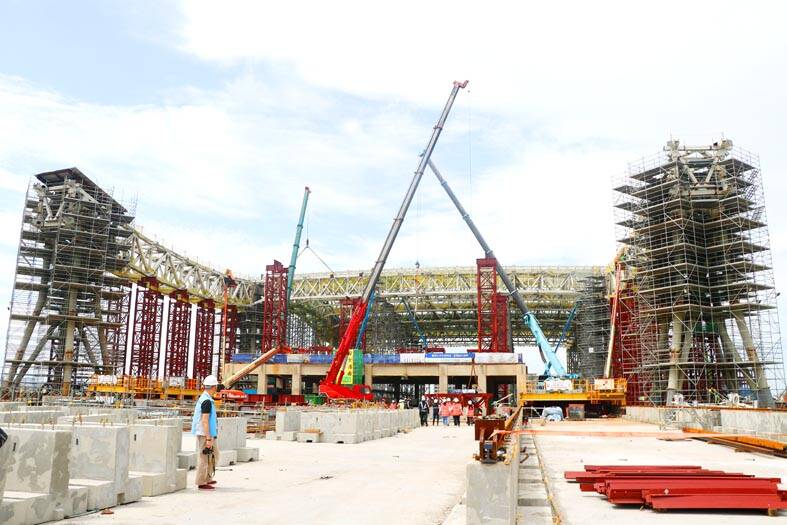The north concourse of Taiwan Taoyuan International Airport’s Terminal 3 is scheduled to begin operations in the middle of next year, Taoyuan International Airport Corp (TIAC) said yesterday.
The Terminal 3 project was launched as the number of air travelers accessing the nation’s largest international airport each year has already exceeded the combined capacity of terminals 1 and 2.
The two existing terminals were designed to be accessed by 37 million air travelers per year. Prior to the COVID-19 pandemic, about 48.36 million accessed the airport in 2019.

Photo: Tsai Yun-jung, Taipei Times
The airport operator yesterday organized a field trip for reporters to see Terminal 3 construction sites.
TIAC chairman Yang Wei-fuu (楊偉甫) told reporters that 26 million air travelers had accessed the airport as of last month, and the number of the air travelers accessing the airport this year could potentially be 44 million to 45 million, which is about 92 to 94 percent of the 2019 level.
Once Terminal 3 is completed, the airport’s passenger service capacity would expand to 82 million travelers per year from 37 million, Yang said.
The company estimated that more than 50 million passengers are to access the airport per year by 2028.
Based on the company’s plan, Terminal 3 would be mainly used for flight services connecting North America and Southeast Asian nations offered by China Airlines, EVA Airways and Starlux Airlines.
As of last month, the nation had welcomed about 3.936 million transit passengers, up from 3.46 million during the same period last year.
About 77 percent of the airport’s transit passengers this year were those traveling between North America and Southeast Asia, TIAC data showed.
Approximately 40 percent of transit travelers flew from the US or Canada to Southeast Asian nations, data showed.
So far, 42.3 percent of the Terminal 3 project — the terminal, aprons, taxiways, substations, an energy center and an office building — has been completed, about 1 percent behind the construction schedule, the company said.
Although the entire Terminal 3 project would not be completed until 2027, the north concourse is scheduled to begin operations in the middle of next year, which could add eight more aircraft parking spaces to the airport, the company said.
The cost of the project is now estimated to be NT$128.37 billion (US$3.97 billion), up from the previous estimate of NT$95.6 billion, due to inflation and other factors, the company said.
The terminal per se costs about NT$44.53 billion. Its rooftop area is about 100,000m2, which is nearly three times larger than the Taipei Dome. The aggregate floor area is about 580,000m2, the company said.
Yang cited the COVID-19 pandemic and the high turnover rate of migrant workers as the two biggest challenges the project has faced, adding that the problem with the migrant workers was addressed by changing human resources agencies.
TIAC sustained substantial financial losses due to the COVID-19 pandemic, turning it from a profitable firm to one in debt.
As of last year, the company had NT$5.4 billion of accumulated financial losses, Yang said.
“We have a very good chance to cover the losses this year due to the return of air travelers. However, we still need to spend about NT$300 billion in the next few years building the third runway and other infrastructure,” he said.

An essay competition jointly organized by a local writing society and a publisher affiliated with the Chinese Communist Party (CCP) might have contravened the Act Governing Relations Between the People of the Taiwan Area and the Mainland Area (臺灣地區與大陸地區人民關係條例), the Mainland Affairs Council (MAC) said on Thursday. “In this case, the partner organization is clearly an agency under the CCP’s Fujian Provincial Committee,” MAC Deputy Minister and spokesperson Liang Wen-chieh (梁文傑) said at a news briefing in Taipei. “It also involves bringing Taiwanese students to China with all-expenses-paid arrangements to attend award ceremonies and camps,” Liang said. Those two “characteristics” are typically sufficient

A magnitude 5.9 earthquake that struck about 33km off the coast of Hualien City was the "main shock" in a series of quakes in the area, with aftershocks expected over the next three days, the Central Weather Administration (CWA) said yesterday. Prior to the magnitude 5.9 quake shaking most of Taiwan at 6:53pm yesterday, six other earthquakes stronger than a magnitude of 4, starting with a magnitude 5.5 quake at 6:09pm, occurred in the area. CWA Seismological Center Director Wu Chien-fu (吳健富) confirmed that the quakes were all part of the same series and that the magnitude 5.5 temblor was

The brilliant blue waters, thick foliage and bucolic atmosphere on this seemingly idyllic archipelago deep in the Pacific Ocean belie the key role it now plays in a titanic geopolitical struggle. Palau is again on the front line as China, and the US and its allies prepare their forces in an intensifying contest for control over the Asia-Pacific region. The democratic nation of just 17,000 people hosts US-controlled airstrips and soon-to-be-completed radar installations that the US military describes as “critical” to monitoring vast swathes of water and airspace. It is also a key piece of the second island chain, a string of

The Central Weather Administration has issued a heat alert for southeastern Taiwan, warning of temperatures as high as 36°C today, while alerting some coastal areas of strong winds later in the day. Kaohsiung’s Neimen District (內門) and Pingtung County’s Neipu Township (內埔) are under an orange heat alert, which warns of temperatures as high as 36°C for three consecutive days, the CWA said, citing southwest winds. The heat would also extend to Tainan’s Nansi (楠西) and Yujing (玉井) districts, as well as Pingtung’s Gaoshu (高樹), Yanpu (鹽埔) and Majia (瑪家) townships, it said, forecasting highs of up to 36°C in those areas